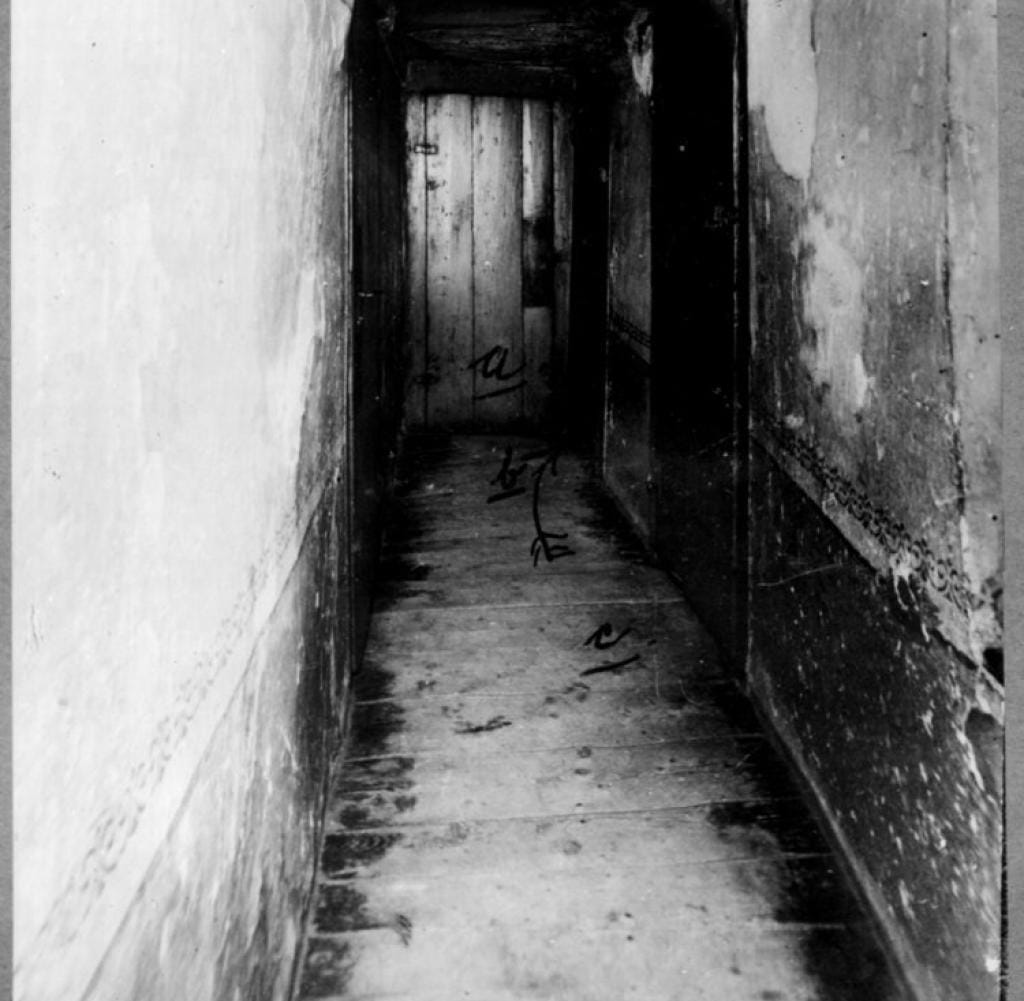Unmasking the “Butcher of Hanover”: Delving into Fritz Haarmann’s Crimes
The story of Fritz Haarmann, a German serial killer from the early 20th century, continues to send chills down spines. Known as the “Butcher of Hanover,” Haarmann’s horrific acts of murder and cannibalism shocked the world. But what drove a seemingly ordinary man to commit such unspeakable atrocities? Let’s delve into the chilling tale of Fritz Haarmann and explore the factors that might have contributed to his transformation into a monster.
A Troubled Past
Born in 1879, Haarmann’s early life was marked by a strained relationship with his father and an unusually close bond with his mother. Some experts suggest that this dysfunctional upbringing may have played a role in his psychological development.
Adding to his troubles, Haarmann’s military career was abruptly cut short. Deemed “unfit for service” due to his erratic behavior and possible mental instability, he was discharged from the army. This event further isolated him and may have exacerbated any underlying mental health issues.
Years of Terror
Between 1918 and 1924, the city of Hanover lived in fear as Haarmann’s reign of terror unfolded. He preyed on young men, often luring them with promises of food, shelter, or employment. Once he had gained their trust, he would overpower them, committing heinous acts of violence and murder. To conceal his crimes, Haarmann would dismember the bodies and dispose of them in the Leine River, earning him the moniker “Vampire of Hanover” for his habit of biting his victims’ throats.
Capture, Trial, and Legacy
Haarmann’s reign of terror finally ended in 1924 when an undercover police investigation led to his arrest. The trial that followed captivated the nation, revealing the gruesome extent of his crimes. Despite pleading insanity, Haarmann was found guilty and sentenced to death. He was executed by beheading in 1925.
Theories and Speculations
The question of what drove Haarmann to commit such horrific acts continues to intrigue criminologists and psychologists today. Was it his troubled childhood, his military discharge, or a combination of factors that converged to create a perfect storm of evil? Some experts even point to a possible neurological condition, as Haarmann was diagnosed with “equivalents to epilepsy” in 1895. While this diagnosis doesn’t excuse his actions, it adds another layer of complexity to the case. Did this possible neurological condition contribute to his violent impulses and the blackouts he often described?
The case of Fritz Haarmann serves as a chilling reminder that monsters can lurk beneath seemingly ordinary exteriors. His story continues to fascinate and horrify, reminding us of the darkness that can reside within the human psyche and the importance of understanding the complex interplay of psychological, social, and biological factors that can contribute to violence.
Unmasking the “Butcher of Hanover”: Delving into Fritz Haarmann’s Mental State
Fritz Haarmann, notorious as the “Butcher of Hanover,” was diagnosed with “equivalents to epilepsy” in 1895, a condition potentially linked to his violent impulses and blackouts. While Haarmann’s epilepsy diagnosis doesn’t excuse his horrific acts, it provides a crucial lens through which to examine his mental state and potential triggers. Did Haarmann’s neurological condition contribute to his transformation from petty criminal to a ruthless serial killer? This examination delves into the complexities of his diagnosis and its potential impact.
Early Life and Criminal Beginnings:
- Fritz Haarmann, born in 1879, displayed troublesome behavior from a young age, engaging in petty theft and displaying signs of potential mental instability.
- His early criminal career further solidified a pattern of deceit, manipulation, and disregard for societal norms.
Military Service and Epilepsy Diagnosis:
- In 1895, at 16, Haarmann entered military service, where he began experiencing periodic lapses in consciousness.
- Initially attributed to “anxiety neurosis,” these episodes were later diagnosed as “equivalent to epilepsy” in October 1895.
- This diagnosis is crucial, as it suggests a potential neurological basis for his behavioral abnormalities.
Post-Military Life and Escalation of Violence:
- Following his military discharge due to “mental deficiency,” Haarmann continued a life of crime, culminating in his first known murder in 1918.
- The question arises: Did his untreated epilepsy and potential neurological vulnerabilities contribute to the escalation of his criminal behavior?
The Butcher of Hanover:
- Between 1918 and 1924, Haarmann committed at least 24 murders, targeting young men and boys.
- His modus operandi often involved luring victims, sexual assault, and subsequent murder, often by biting through the throat.
- Were these acts of extreme violence linked to epileptic episodes or other underlying mental health issues exacerbated by a lack of proper treatment?
Trial and Execution:
- During his trial, Haarmann’s mental state was a point of contention, but his epilepsy diagnosis was not presented as a mitigating factor.
- He was found guilty and executed by guillotine in 1925.
Unique Insights & Untapped Potential:
- Exploring the Medical Understanding of Epilepsy in the Early 20th Century: Researching how epilepsy was perceived and treated during Haarmann’s time can offer valuable context for understanding the potential impact of his diagnosis.
- Examining the Link Between Epilepsy and Violence: While a direct causal link is generally not established, exploring the complex relationship between certain types of epilepsy and potential for aggression or impulsivity can provide valuable insights.
- Analyzing Haarmann’s Case Within the Context of Post-World War I Germany: Investigating the societal and economic turmoil of post-war Germany could shed light on contributing factors to Haarmann’s descent into violence and the broader social anxieties surrounding his crimes.
Unveiling Hans Grans: Beyond the Shadow of the Butcher of Hanover
Was Hans Grans a willing participant in Fritz Haarmann’s crimes, or a victim manipulated by a cunning predator? The exact nature of Hans Grans’ involvement in the Haarmann murders remains shrouded in controversy, with conflicting accounts and unanswered questions. More than just an accomplice, Hans Grans offers a unique perspective into the life and mind of one of Germany’s most notorious serial killers. Examining the life of Hans Grans reveals a tragic tale of poverty, exploitation, and the complexities of human relationships.
Early Life and Relationship with Haarmann:
- Hans Grans: A young drifter who crossed paths with Fritz Haarmann in 1922 at Hanover’s central station.
- Early Life: After running away from home, Grans resorted to petty theft and selling old clothes to survive.
- Relationship with Haarmann: Their relationship began as lovers but later became entangled with Haarman’s criminal activities.
The Crimes and the Controversy:
- Haarmann’s Crimes: Between 1918 and 1924, Fritz Haarmann, known as the “Butcher of Hanover,” murdered at least 24 young men.
- Grans’ Alleged Involvement: The extent of Grans’ participation in the murders remains unclear and heavily disputed.
- Conflicting Accounts: While some sources suggest that Grans actively helped lure victims and dispose of bodies, possibly driven by jealousy over their clothing, other evidence portrays him as a victim of Haarmann’s manipulations.
The Trial and Aftermath:
- Trial: The trial of Haarmann and Grans commenced on December 4, 1924.
- Charges: Haarmann faced charges for the murders of 27 boys and young men.
- Verdict: Ultimately, Haarmann was found guilty and sentenced to death by guillotine.
- Grans’ Sentence: Grans received a 12-year prison sentence for his role.
Unanswered Questions and Historical Significance:
- Limited Information: Details about Hans Grans’ life outside his connection to Haarmann are scarce.
- Historical Context: The Haarmann case, set against the backdrop of post-World War I Germany’s social and economic turmoil, has been the subject of numerous studies and analyses.
- Continuing Debate: The question of whether Grans was a willing accomplice or a victim of circumstance continues to fuel debate among historians and criminologists.
Have you heard of a tragedy that befell the students of Erfurt University back in 1623? To know more about the details of the incident, click on the active link Erfurt latrine disaster. Also, can you believe that there is a castle located on a high rock in the middle of the Moselle River? If you are curious about Eltz Castle, click the link Eltz Burg castle and it will direct you to the right page.
- Discover Long Black Pepper: Flavor & Health Benefits - April 25, 2025
- Shocking Twists: The Grownup Review: Unreliable Narration - April 25, 2025
- A Quiet Place Book vs Movie: A Deep Dive - April 25, 2025
















